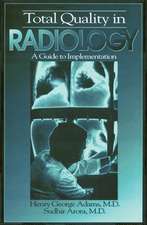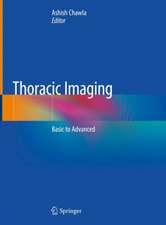Magnetic Resonance Imaging of Carcinoma of the Urinary Bladder: Series in Radiology, cartea 21
Autor Jelle O. Barentsz, Frans M. J. Debruyne, J.H.J. Ruijsen Limba Engleză Paperback – 11 noi 2011
Din seria Series in Radiology
- 5%
 Preț: 437.14 lei
Preț: 437.14 lei - 5%
 Preț: 370.21 lei
Preț: 370.21 lei - 5%
 Preț: 366.19 lei
Preț: 366.19 lei - 5%
 Preț: 348.95 lei
Preț: 348.95 lei - 5%
 Preț: 366.19 lei
Preț: 366.19 lei -
 Preț: 367.86 lei
Preț: 367.86 lei - 5%
 Preț: 369.45 lei
Preț: 369.45 lei - 5%
 Preț: 363.60 lei
Preț: 363.60 lei - 5%
 Preț: 396.71 lei
Preț: 396.71 lei - 5%
 Preț: 366.19 lei
Preț: 366.19 lei - 5%
 Preț: 715.91 lei
Preț: 715.91 lei - 5%
 Preț: 710.06 lei
Preț: 710.06 lei - 5%
 Preț: 367.07 lei
Preț: 367.07 lei - 5%
 Preț: 715.91 lei
Preț: 715.91 lei - 5%
 Preț: 385.94 lei
Preț: 385.94 lei - 5%
 Preț: 1408.43 lei
Preț: 1408.43 lei - 5%
 Preț: 379.69 lei
Preț: 379.69 lei - 5%
 Preț: 670.96 lei
Preț: 670.96 lei - 5%
 Preț: 1416.30 lei
Preț: 1416.30 lei
Preț: 340.64 lei
Preț vechi: 358.56 lei
-5% Nou
Puncte Express: 511
Preț estimativ în valută:
65.20€ • 70.85$ • 54.81£
65.20€ • 70.85$ • 54.81£
Carte tipărită la comandă
Livrare economică 16-22 aprilie
Preluare comenzi: 021 569.72.76
Specificații
ISBN-13: 9789401067782
ISBN-10: 9401067783
Pagini: 136
Ilustrații: 136 p.
Dimensiuni: 193 x 260 x 7 mm
Ediția:Softcover reprint of the original 1st ed. 1990
Editura: SPRINGER NETHERLANDS
Colecția Springer
Seria Series in Radiology
Locul publicării:Dordrecht, Netherlands
ISBN-10: 9401067783
Pagini: 136
Ilustrații: 136 p.
Dimensiuni: 193 x 260 x 7 mm
Ediția:Softcover reprint of the original 1st ed. 1990
Editura: SPRINGER NETHERLANDS
Colecția Springer
Seria Series in Radiology
Locul publicării:Dordrecht, Netherlands
Public țintă
ResearchCuprins
I. Introduction.- 1.1 Magnetic spin tomography.- 1.2 Carcinoma of the urinary bladder.- 1.3 Diagnostic imaging of carcinoma of the urinary bladder.- 1.4 Aims and design of this study.- II. General Principles Of MRI.- 2.1 Introduction.- 2.2 Basic physics of MRI.- 2.3 Image contrast.- 2.4 Strength of the magnetic field.- 2.5 Artifacts.- 2.6 Advantages of MRI over other imaging techniques.- 2.7 Disadvantages of MRI compared with other imaging techniques.- 2.8 Safety of MRI.- 2.9 Contraindications for MRI investigation.- III. Technical Aspects of Mri Specificially Relevant to Patients with Urinary Bladder Carcinoma.- 3.1 Introduction, optimal conditions for examination.- 3.2 Patient-related factors.- 3.3 Pulse sequence optimization.- 3.4 Body-coil MRI versus (double) surface-coil MRI.- 3.5 Comparison of staging results at 0.5 T and 1.5 T.- 3.6 Conclusion and protocol to be followed.- IV. Normal Mr Images: Correlation With Known Anatomic Proportions.- 4.1 Normal MR images of the pelvis.- 4.2 Correlation of MR images with anatomic sections.- 4.3 Correlations of MR images with sections of resected specimens.- V. Staging of Carcinoma of the Urinary Bladder on the Basis of MRI Results.- 5.1 Introduction.- 5.2 Evaluation of MRI, CT, and the clinical staging method compared with postoperative histopathologic staging based on cystectomy and autopsy specimens.- 5.3. Evaluation of staging with MRI and CT by using a combination of clinical staging and follow-up as a reference.- 5.4 Evaluation of staging with MRI by using a combination of clinical staging and follow-up as a reference.- VI. Discussion, Conclusions and Future Perspectives.- 6.1 Discussion and conclusions.- 6.2 Future prospects.- VII. Summary.- References.





















